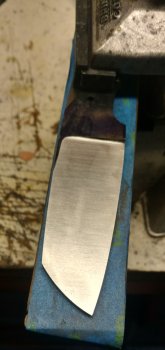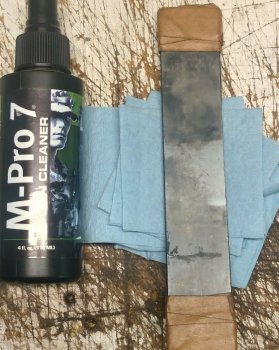Ty Adams
KNIFE MAKER
I just thought I'd share a few things that I have learned over the last couple of knives. I enjoy hand sanding it is the point where the knife really starts to shine. With that said I have been looking for ways to cut that time down.
The first thing I can't take credit for. John Wilson mentioned it in post. Thanks John. It was adding a piece of leather as a backer to your sanding block. It makes a huge difference in how long it takes to get out previous scratches.
The second was doing my final grind with a 400 grit cork belt. The combination of the 2 has cut my hand sanding time in half.
Here's the knife fresh off the grinder.

Here it is 10 minutes later at a dirty 800 grit.

Now it will take me another 10 minutes to clean this up and have a clean finish. I was just amazed at how those two small things made all the difference in the world. I'm sure all the people that have been at this for awhile already knew about this. I just wanted to share.
The first thing I can't take credit for. John Wilson mentioned it in post. Thanks John. It was adding a piece of leather as a backer to your sanding block. It makes a huge difference in how long it takes to get out previous scratches.
The second was doing my final grind with a 400 grit cork belt. The combination of the 2 has cut my hand sanding time in half.
Here's the knife fresh off the grinder.

Here it is 10 minutes later at a dirty 800 grit.

Now it will take me another 10 minutes to clean this up and have a clean finish. I was just amazed at how those two small things made all the difference in the world. I'm sure all the people that have been at this for awhile already knew about this. I just wanted to share.

